The Study of SRM Sensorless Control Strategy Based on SOGI-FLL and ADRC-PLL Hybrid Algorithm
Abstract
:1. Introduction
2. Overall Control Scheme and Working Mode Analysis
2.1. Introduction to the Overall Control Program
2.2. Analysis of Motor Operating Modes
3. Inductance Model Reconstruction Based on Vector Transformation
4. Rotor Position Estimation Based on Hybrid Algorithm for SRM
4.1. Calculation of Rotor Position Error Based on Unsaturated Inductance Difference Method
4.2. Improved SOGI-FLL Controller Speed Estimation
4.2.1. The Design and Analysis of SOGI
4.2.2. The Design and Analysis of FLL-ISP-PI
4.3. Improved ADRC-PLL Controller Position Estimation
4.3.1. The Design of ESO
4.3.2. The Design of NLSEF
5. Simulation Studies and Experimental Verification
5.1. Simulation Studies
5.1.1. Motor Control Simulation Model Construction
5.1.2. Verification and Analysis of Harmonic Suppression for Reconstructed Inductance Models
5.1.3. Simulation and Analysis of Sensorless Control Strategy
- (1)
- Simulation analysis of motor speed
- (2)
- Simulation analysis of motor rotor position estimation
- (3)
- Simulation analysis of torque variations and disturbances
5.2. Experimental Verification
6. Conclusions
Author Contributions
Funding
Data Availability Statement
Conflicts of Interest
Nomenclature
| The incremental inductance | |
| The first coordinate transformation inductance | |
| The second coordinate transformation inductance. | |
| The fundamental component of the Fourier expansion. | |
| The amplitude of the or -axis | |
| The normalized reconstructed inductance | |
| The negative proportional gain | |
| The initial angular frequency | |
| The frequency error | |
| The rotor position error of actual and estimated | |
| The amplitude of the rotor position error | |
| The estimated position angle | |
| The actual position angle | |
| The number of rotor poles | |
| The threshold of error | |
| The switching coefficient of the integral term | |
| The rate at which it decays to zero | |
| The rotor predicted angle observation signal | |
| The rotor angular velocity observation signal | |
| The disturbance observation signal |
References
- Chaibet, A.; Boukhnifer, M.; Ouddah, N.; Monmasson, E. Experimental Sensorless Control of Switched Reluctance Motor for Electrical Powertrain System. Energies 2020, 13, 3081. [Google Scholar] [CrossRef]
- Ge, L.; Burkhart, B.; Doncker, R.W.D. Fast Iron Loss and Thermal Prediction Method for Power Density and Efficiency Improvement in Switched Reluctance Machines. IEEE Trans. Ind. Electron. 2020, 67, 4463–4473. [Google Scholar] [CrossRef]
- Bilgin, B.; Howey, B.; Callegaro, A.D.; Liang, J.; Kordic, M.; Taylor, J.; Emadi, A. Making the Case for Switched Reluctance Motors for Propulsion Applications. IEEE Trans. Veh. Technol. 2020, 69, 7172–7186. [Google Scholar] [CrossRef]
- Cheng, H.; Liao, S.; Yan, W. Development and Performance Analysis of Segmented-Double-Stator Switched Reluctance Machine. IEEE Trans. Ind. Electron. 2022, 69, 1298–1309. [Google Scholar] [CrossRef]
- Lan, Y.; Benomar, Y.; Deepak, K.; Aksoz, A.; El Baghdadi, M.; Bostanci, E.; Hegazy, O. Switched Reluctance Motors and Drive Systems for Electric Vehicle Powertrains: State of the Art Analysis and Future Trends. Energies 2021, 14, 2079. [Google Scholar] [CrossRef]
- Wang, G.; Valla, M.; Solsona, J. Position Sensorless Permanent Magnet Synchronous Machine Drives—A Review. IEEE Trans. Ind. Electron. 2020, 67, 5830–5842. [Google Scholar] [CrossRef]
- Xiao, D.; Filho, S.R.; Fang, G.; Ye, J.; Emadi, A. Position-Sensorless Control of Switched Reluctance Motor Drives: A Review. IEEE Trans. Transp. Electrif. 2022, 8, 1209–1227. [Google Scholar] [CrossRef]
- Tang, X.T.; Sun, X.D.; Yao, M. An Overview of Position Sensorless Techniques for Switched Reluctance Machine Systems. Appl. Sci. 2022, 12, 3616. [Google Scholar] [CrossRef]
- Pasquesoone, G.; Mikail, R.; Husain, I. Position Estimation at Starting and Lower Speed in Three-Phase Switched Reluctance Machines Using Pulse Injection and Two Thresholds. IEEE Trans. Ind. Appl. 2011, 47, 1724–1731. [Google Scholar] [CrossRef]
- Gan, C.; Chen, Y.; Sun, Q.; Si, J.; Wu, J.; Hu, Y. A Position Sensorless Torque Control Strategy for Switched Reluctance Machines With Fewer Current Sensors. IEEE/ASME Trans. Mechatron. 2021, 26, 1118–1128. [Google Scholar] [CrossRef]
- Sun, X.; Tang, X.; Tian, X.; Wu, J.; Zhu, J. Position Sensorless Control of Switched Reluctance Motor Drives Based on a New Sliding Mode Observer Using Fourier Flux Linkage Model. IEEE Trans. Energy Convers. 2022, 37, 978–988. [Google Scholar] [CrossRef]
- Cai, H.; Han, Y.J.; Jiang, Y.J.; Luo, Z.X.; Liao, J.L. Flexible Sensorless Position Control of Switched Reluctance Motors considering Both Embrace Design and Magnetic Saturation. Front. Energy Res. 2022, 10, 822021. [Google Scholar] [CrossRef]
- Wang, Y.; Ma, Z.; Bahari, M. Position Estimation Method for Switched Reluctance Motors Based on Magnetic Flux Modulation. IEEE Sens. J. 2023, 23, 10395–10403. [Google Scholar] [CrossRef]
- Kim, J.H.; Kim, R.Y. Online sensorless position estimation for switched reluctance motors using characteristics of overlap position based on inductance profile. IET Electr. Power Appl. 2019, 13, 456–462. [Google Scholar] [CrossRef]
- Cai, J.; Zhang, X.; Peng, X.; Yan, Y.; Deng, Z. A Hybrid Sensorless Starting Strategy for SRM With Fault-Tolerant Capability. IEEE Trans. Transp. Electrif. 2023, 9, 2444–2452. [Google Scholar] [CrossRef]
- Kolluru, A.K.; Malligunta, K.K.; Teja, S.R.; Reddy, C.R.; Alqahtani, M.; Khalid, M. A novel controller for PV-fed water pumping optimization system driven by an 8/6 pole SRM with asymmetrical converter. Front. Energy Res. 2023, 11, 1205704. [Google Scholar] [CrossRef]
- Kuang, S.; Zhang, X.; Liu, P.; Zhang, G.; Zhang, Z. Sensorless Control Method for Switched Reluctance Motors Based on Locations of Phase Inductance Characteristic Points. Trans. China Electrotech. Soc. 2020, 35, 4296–4305. [Google Scholar]
- Cai, Y.; Wang, Y.; Xu, H.; Sun, S.; Wang, C.; Sun, L. Research on Rotor Position Model for Switched Reluctance Motor Using Neural Network. IEEE/ASME Trans. Mechatron. 2018, 23, 2762–2773. [Google Scholar]
- Zhang, L.; Liu, C.; Wang, Y.; Zhang, Y. Position Sensorless Technology of Switched Reluctance Machines Based on Double Variable Current Thresholds. Proc. Chin. Soc. Electr. Eng. 2014, 34, 4683–4690. [Google Scholar]
- Li, M.; Chen, X.; Ren, X.; Li, Y. Sensorless Control of Switched Reluctance Motors Based on Typical Positions of Three-Phase Inductances. Proc. Chin. Soc. Electr. Eng. 2017, 37, 3901–3908. [Google Scholar]
- Xu, A.; Ren, P.; Chen, J.; Zhu, J. Rotor Position Detection and Error Compensation of Switched Reluctance Motor Based on Special Inductance Position. Trans. China Electrotech. Soc. 2020, 35, 1613–1623. [Google Scholar]
- Banerjee, R.; Sensarma, P. Low-Cost Realization of Feature Position Estimation Scheme for Switched Reluctance Motor. IEEE Trans. Power Electron. 2023, 38, 2850–2854. [Google Scholar] [CrossRef]
- Kim, J.-H.; Kim, R.-Y. Sensorless Direct Torque Control Using the Inductance Inflection Point for a Switched Reluctance Motor. IEEE Trans. Ind. Electron. 2018, 65, 9336–9345. [Google Scholar] [CrossRef]
- Cai, J.; Liu, Z.Y.; Zeng, Y. Aligned Position Estimation Based Fault-Tolerant Sensorless Control Strategy for SRM Drives. IEEE Trans. Power Electron. 2019, 34, 7754–7762. [Google Scholar] [CrossRef]
- Cai, J.; Deng, Z. Sensorless Control of Switched Reluctance Motors Based on Full-Cycle Inductance Method. Trans. China Electrotech. Soc. 2013, 28, 145–154. [Google Scholar]
- Fang, G.; Scalcon, F.P.; Volpato Filho, C.J.V.; Xiao, D.; Nahid-Mobarakeh, B.; Emadi, A. A Unified Wide-Speed Range Sensorless Control Method for Switched Reluctance Machines Based on Unsaturated Reluctance. IEEE Trans. Ind. Electron. 2023, 70, 9903–9913. [Google Scholar] [CrossRef]
- Mese, E.; Torrey, D.A. An approach for sensorless position estimation for switched reluctance motors using artifical neural networks. IEEE Trans. Power Electron. 2002, 17, 66–75. [Google Scholar] [CrossRef]
- Xiao, D.; Ye, J.; Fang, G.; Xia, Z.; Li, H.; Wang, X.; Nahid-Mobarakeh, B.; Emadi, A. Induced Current Reduction in Position-Sensorless SRM Drives Using Pulse Injection. IEEE Trans. Ind. Electron. 2023, 70, 4620–4630. [Google Scholar] [CrossRef]
- Xiao, D.; Ye, J.; Fang, G.; Xia, Z.; Wang, X.; Emadi, A. A Regional Phase-Locked Loop-Based Low-Speed Position-Sensorless Control Scheme for General-Purpose Switched Reluctance Motor Drives. IEEE Trans. Power Electron. 2022, 37, 5859–5873. [Google Scholar] [CrossRef]
- Cai, J.; Deng, Z. Unbalanced Phase Inductance Adaptable Rotor Position Sensorless Scheme for Switched Reluctance Motor. IEEE Trans. Power Electron. 2018, 33, 4285–4292. [Google Scholar] [CrossRef]
- Cai, J.; Liu, Z. An Unsaturated Inductance Reconstruction Based Universal Sensorless Starting Control Scheme for SRM Drives. IEEE Trans. Ind. Electron. 2020, 67, 9083–9092. [Google Scholar] [CrossRef]
- Fortuna, L.; Frasca, M.; Buscarino, A. Optimal and Robust Control: Advanced Topics with MATLAB®; CRC Press: Boca Raton, FL, USA, 2021. [Google Scholar]
- Sun, X.; Wu, J.; Lei, G.; Guo, Y.; Zhu, J. Torque ripple reduction of SRM drive using improved direct torque control with sliding mode controller and observer. IEEE Trans. Ind. Electron. 2020, 68, 9334–9345. [Google Scholar] [CrossRef]
- Bucolo, M.; Buscarino, A.; Fortuna, L.; Gagliano, S. Can Noise in the Feedback Improve the Performance of a Control System? J. Phys. Soc. Jpn. 2021, 90, 075002. [Google Scholar] [CrossRef]

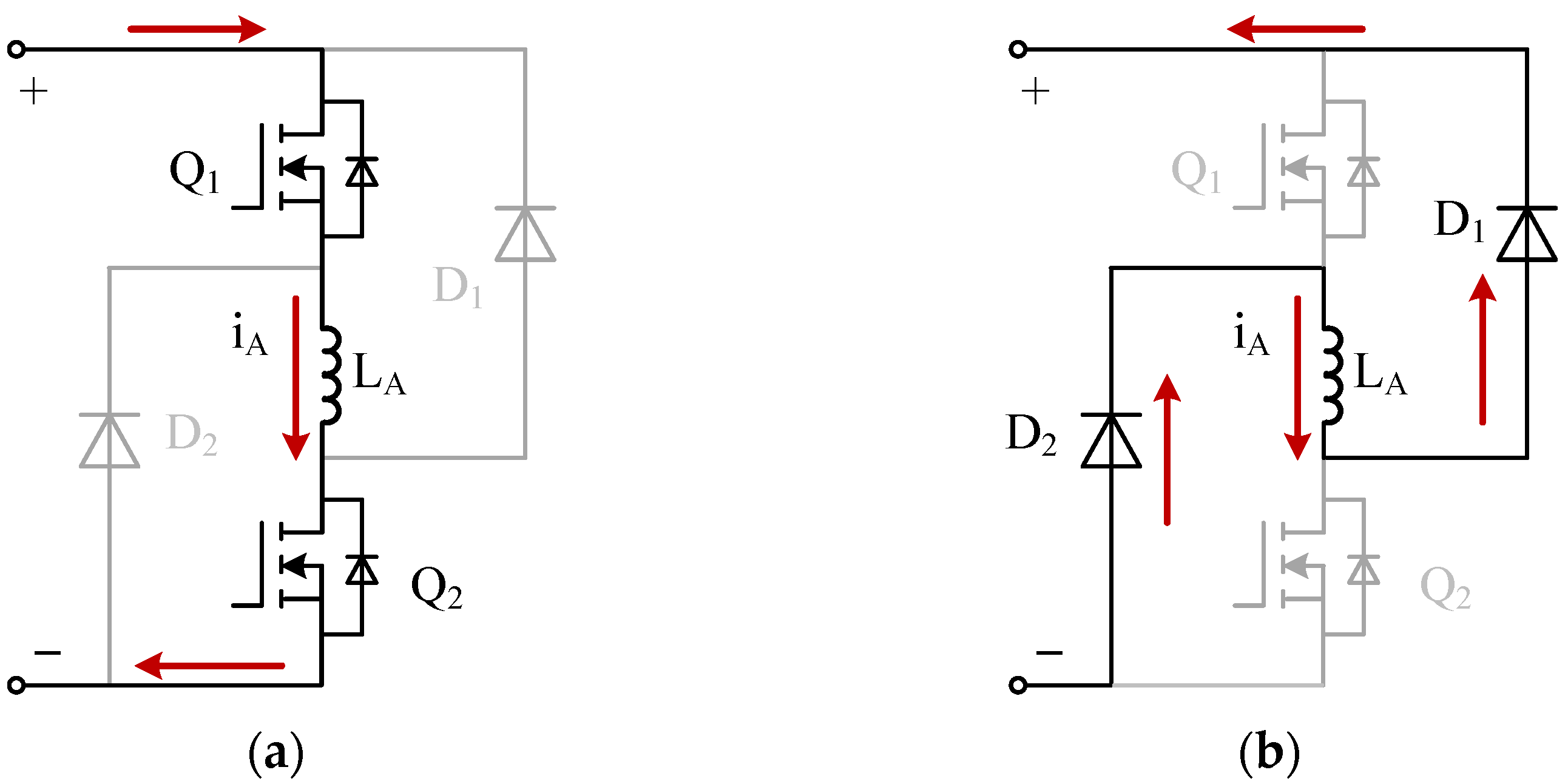
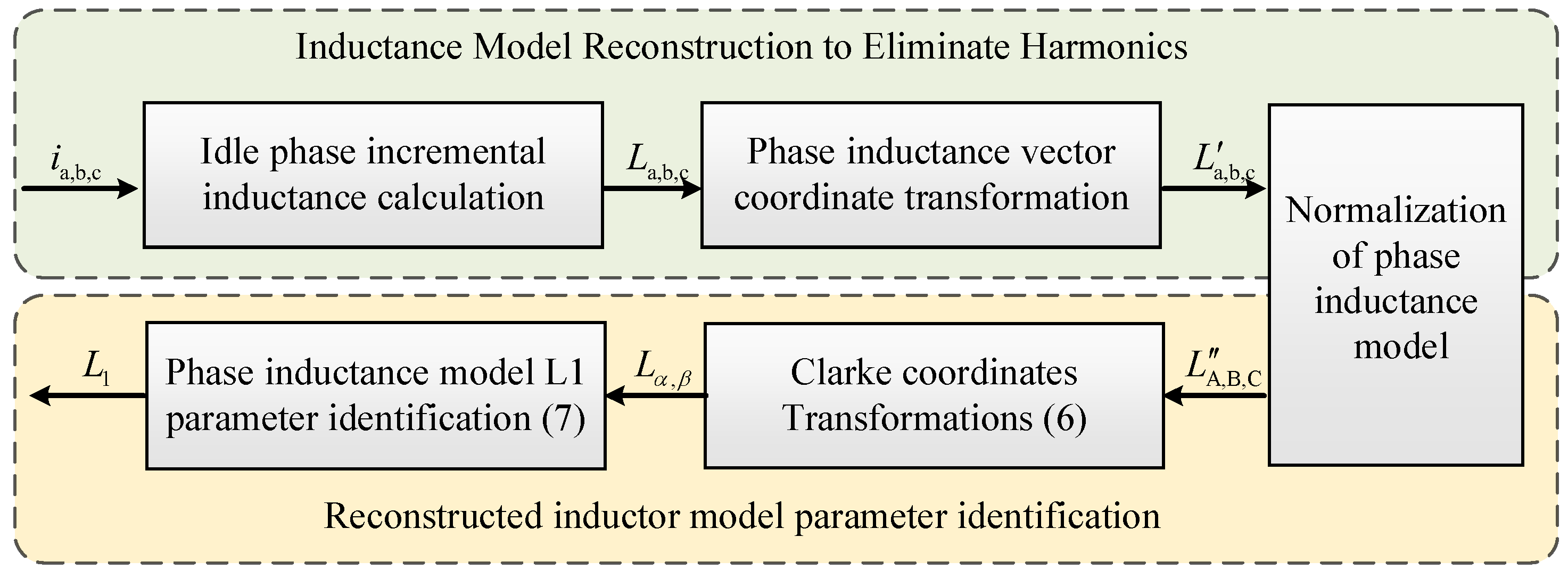


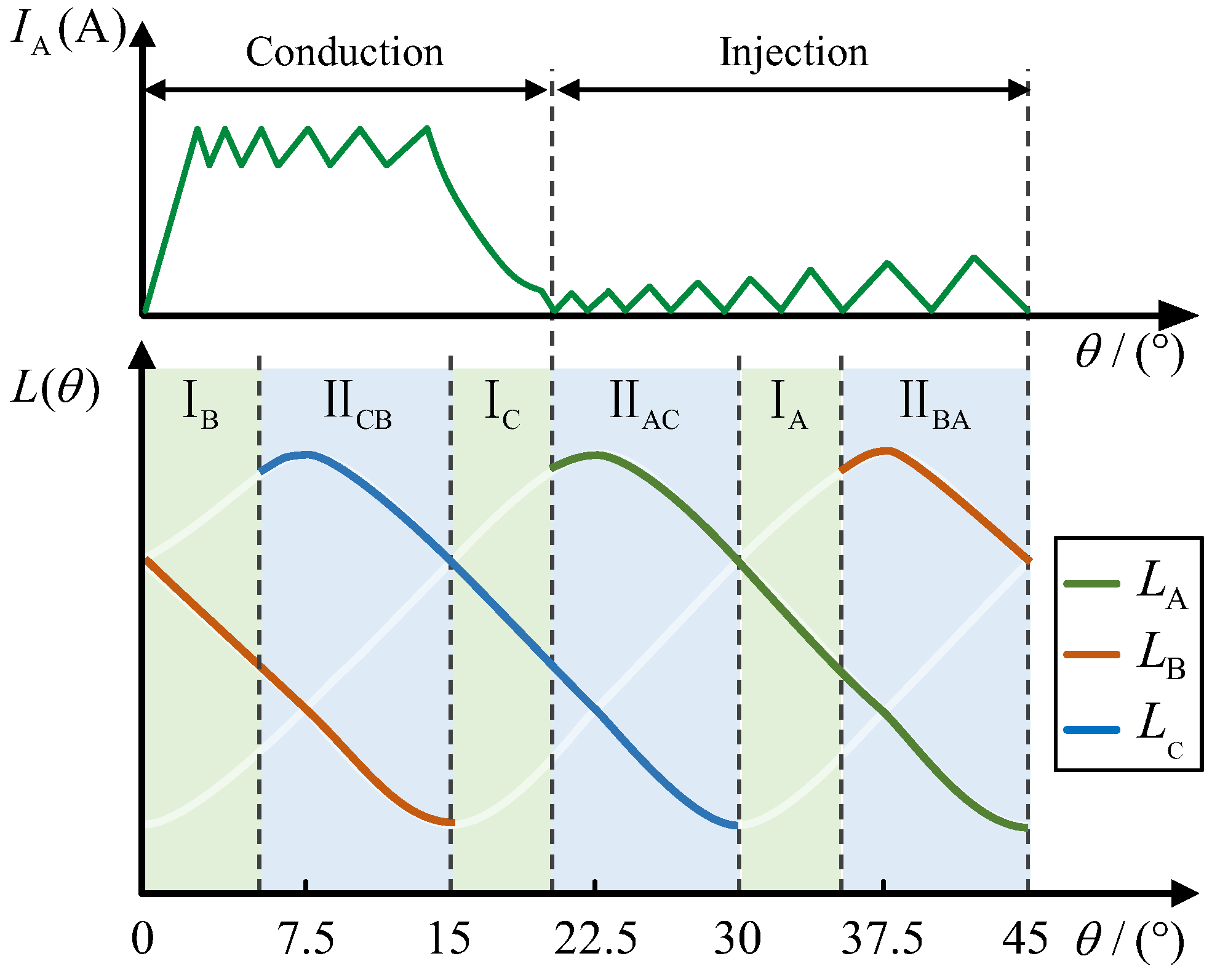
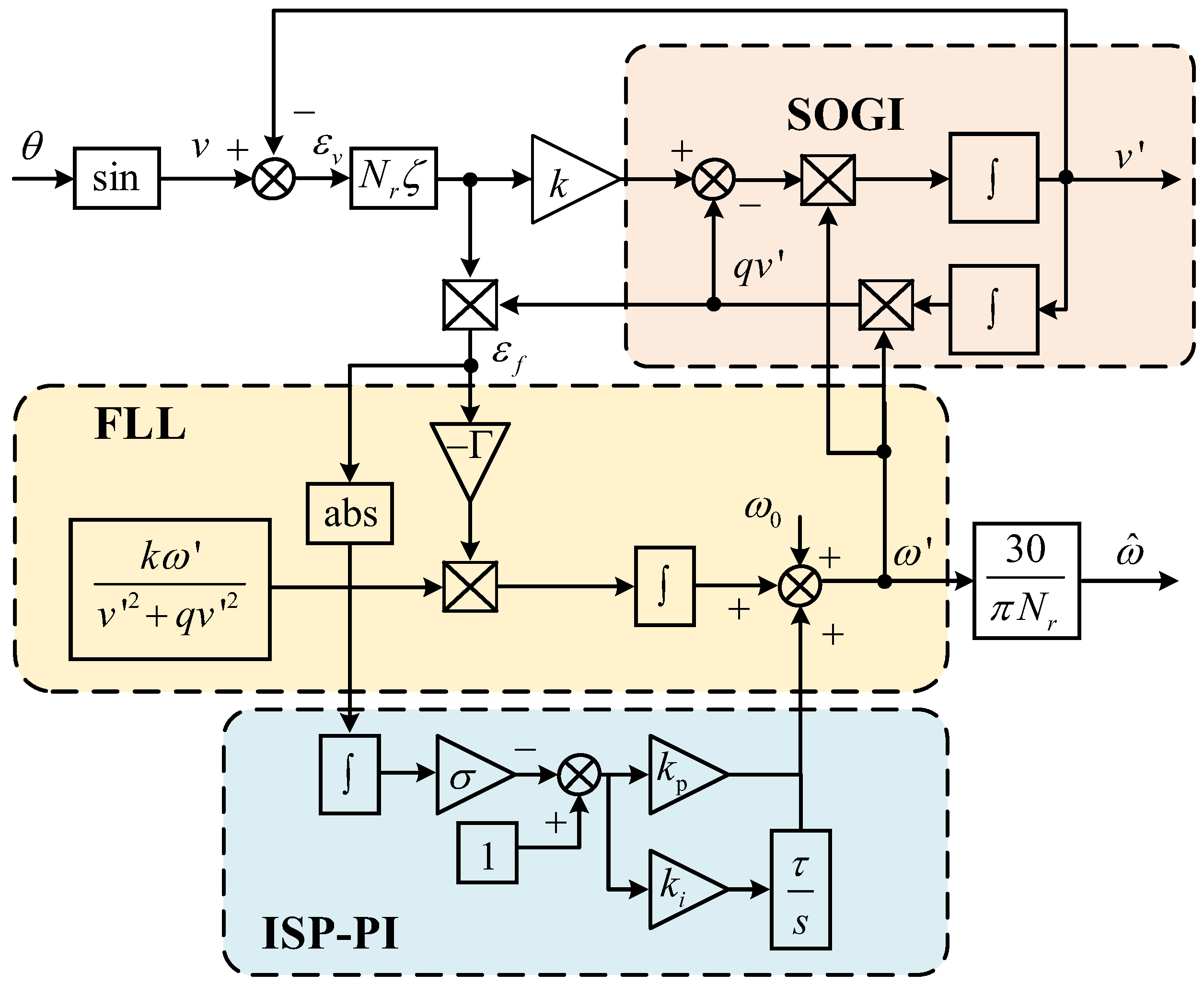
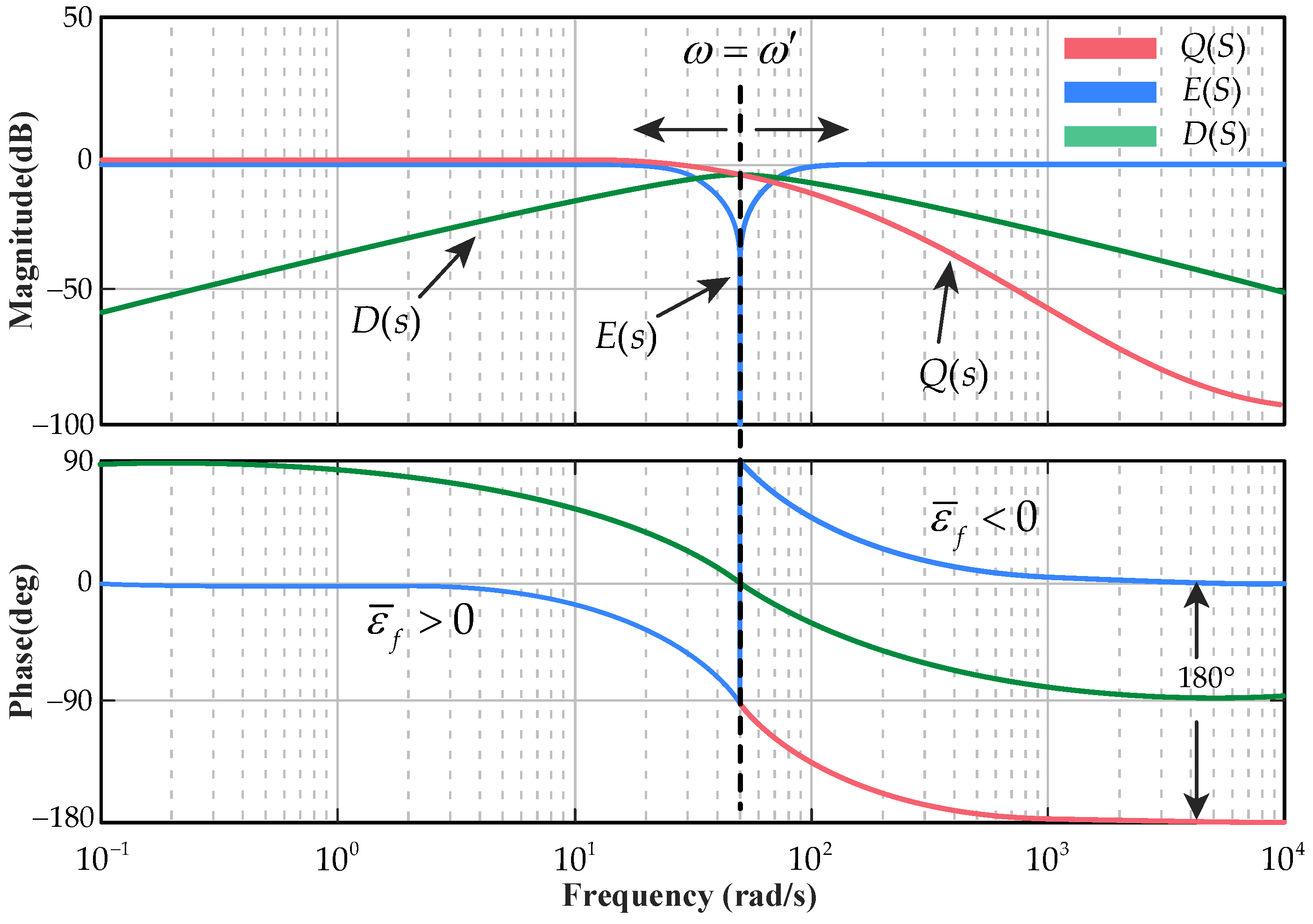
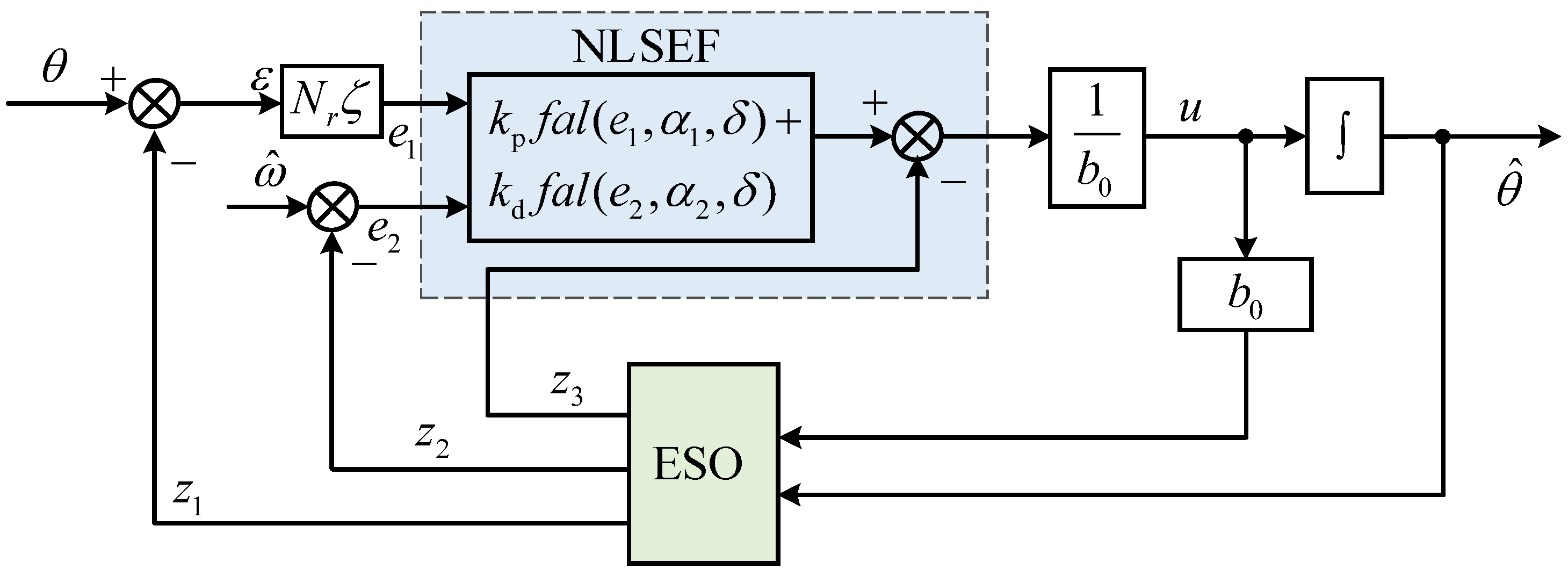
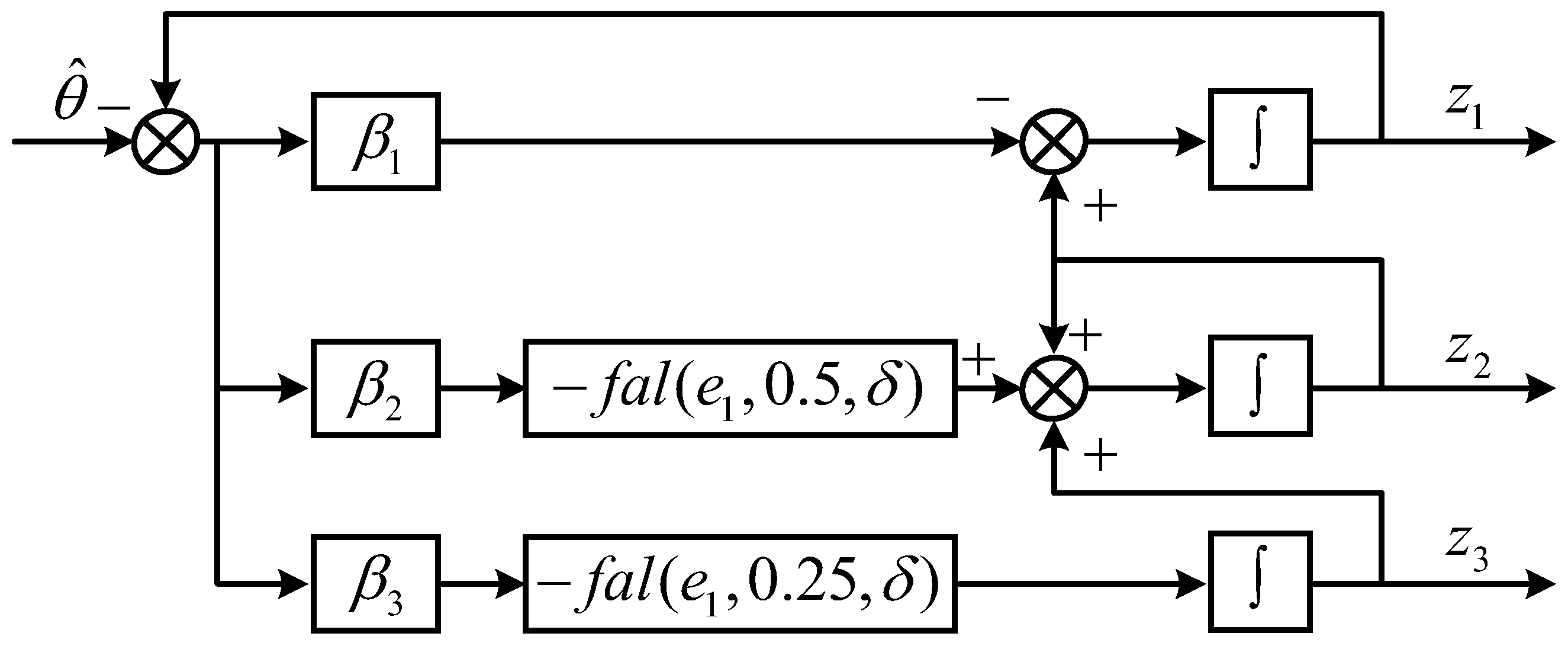

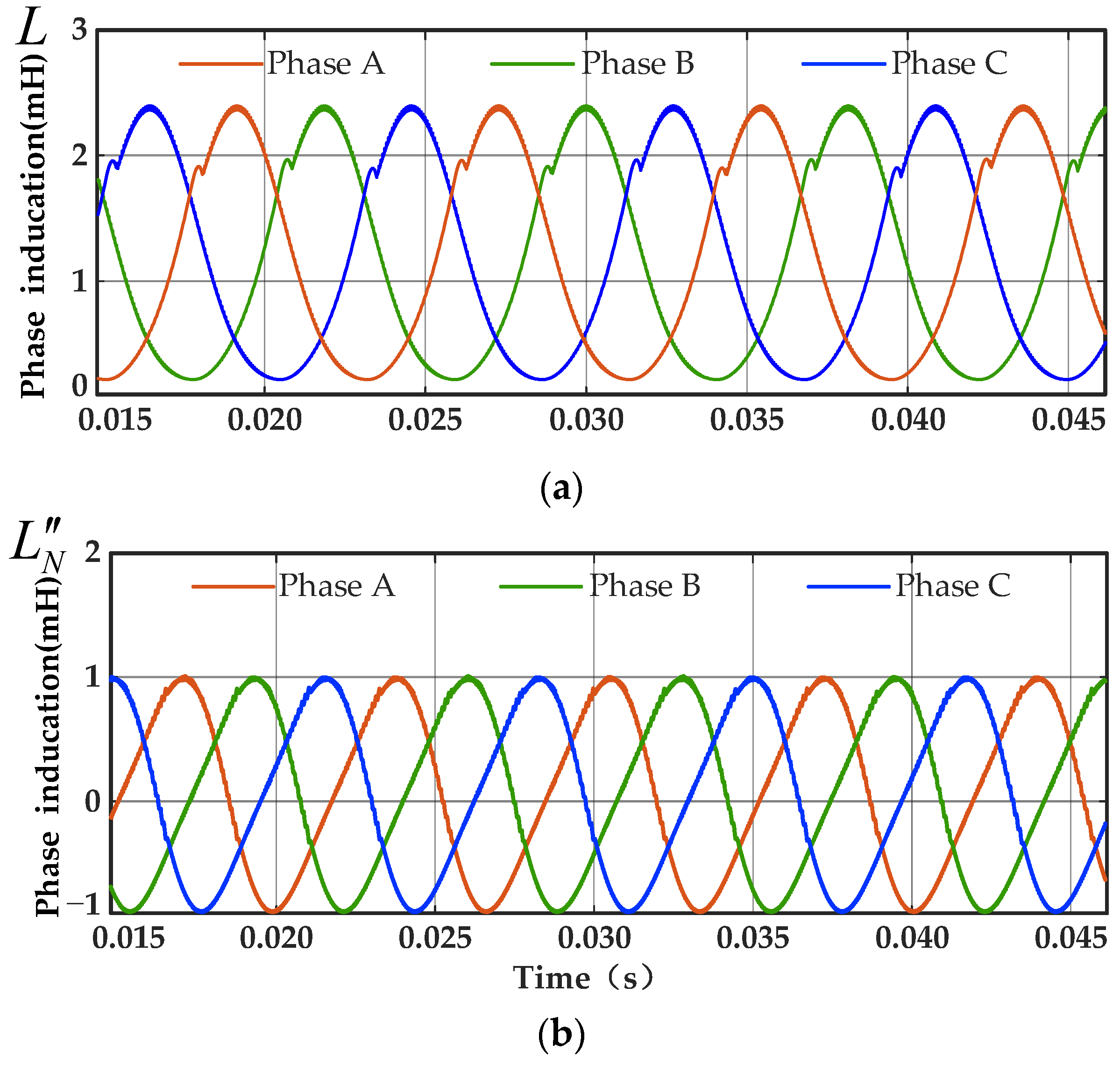
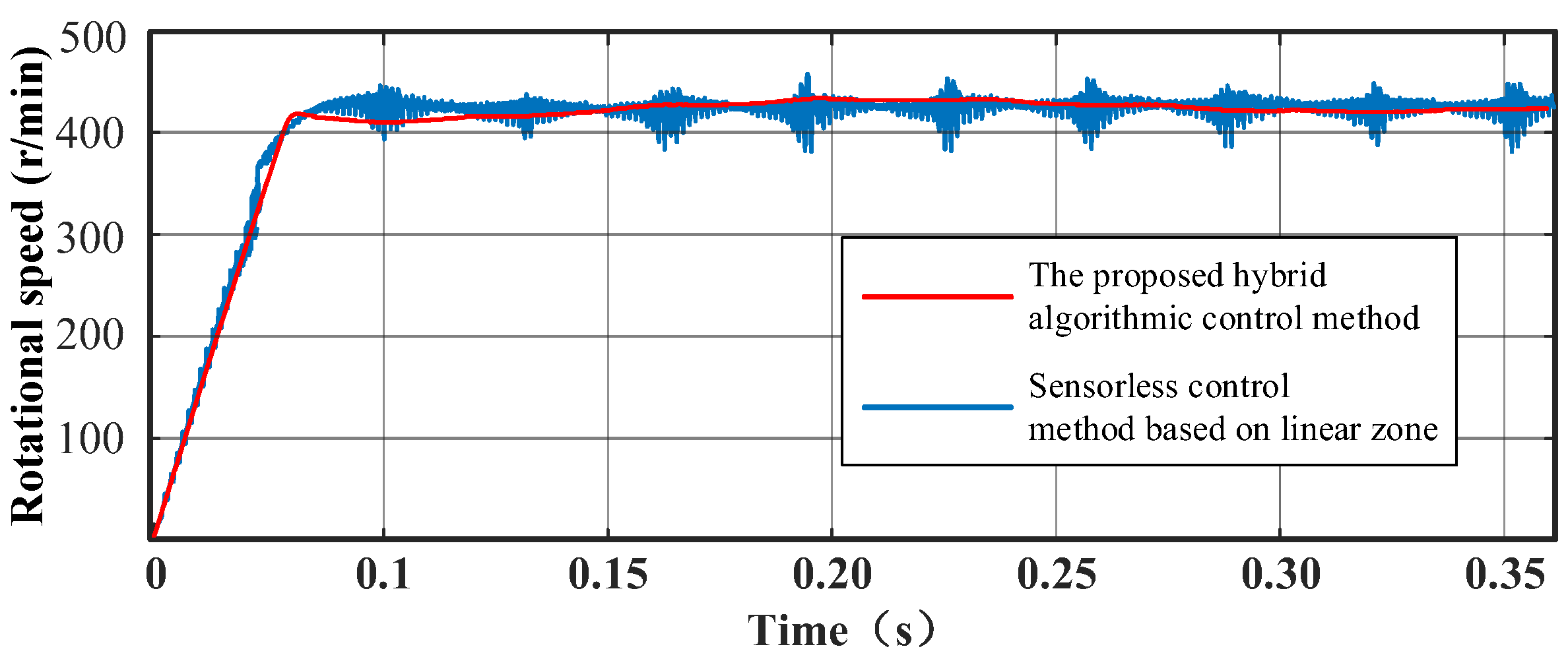

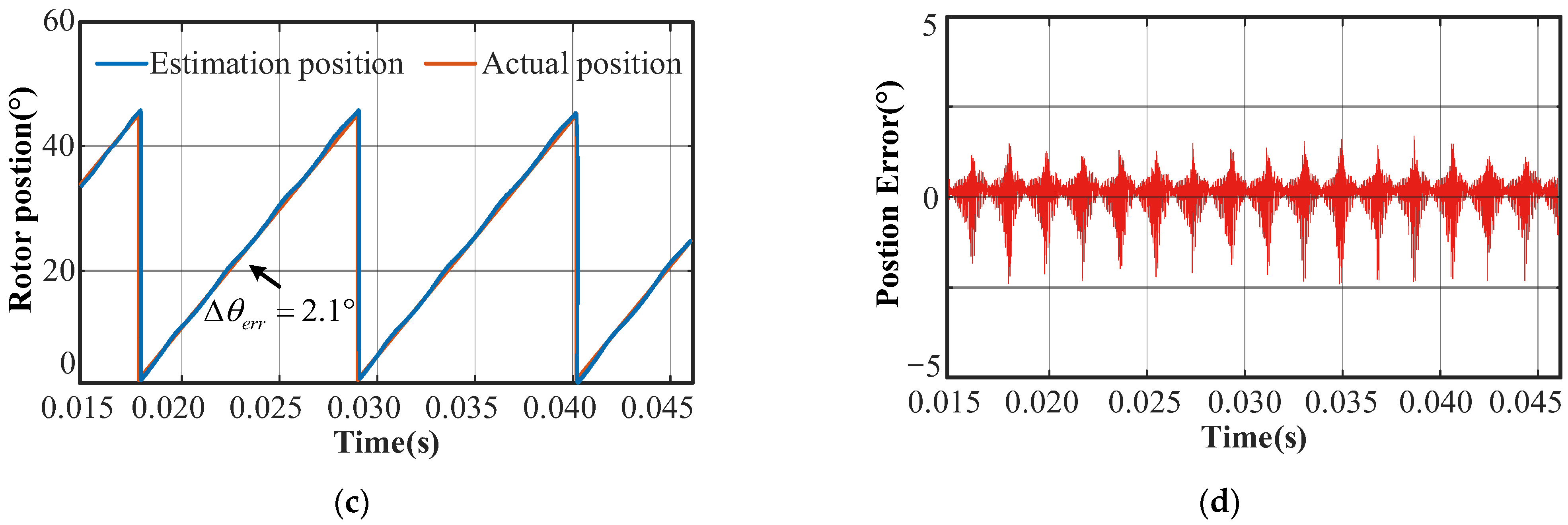





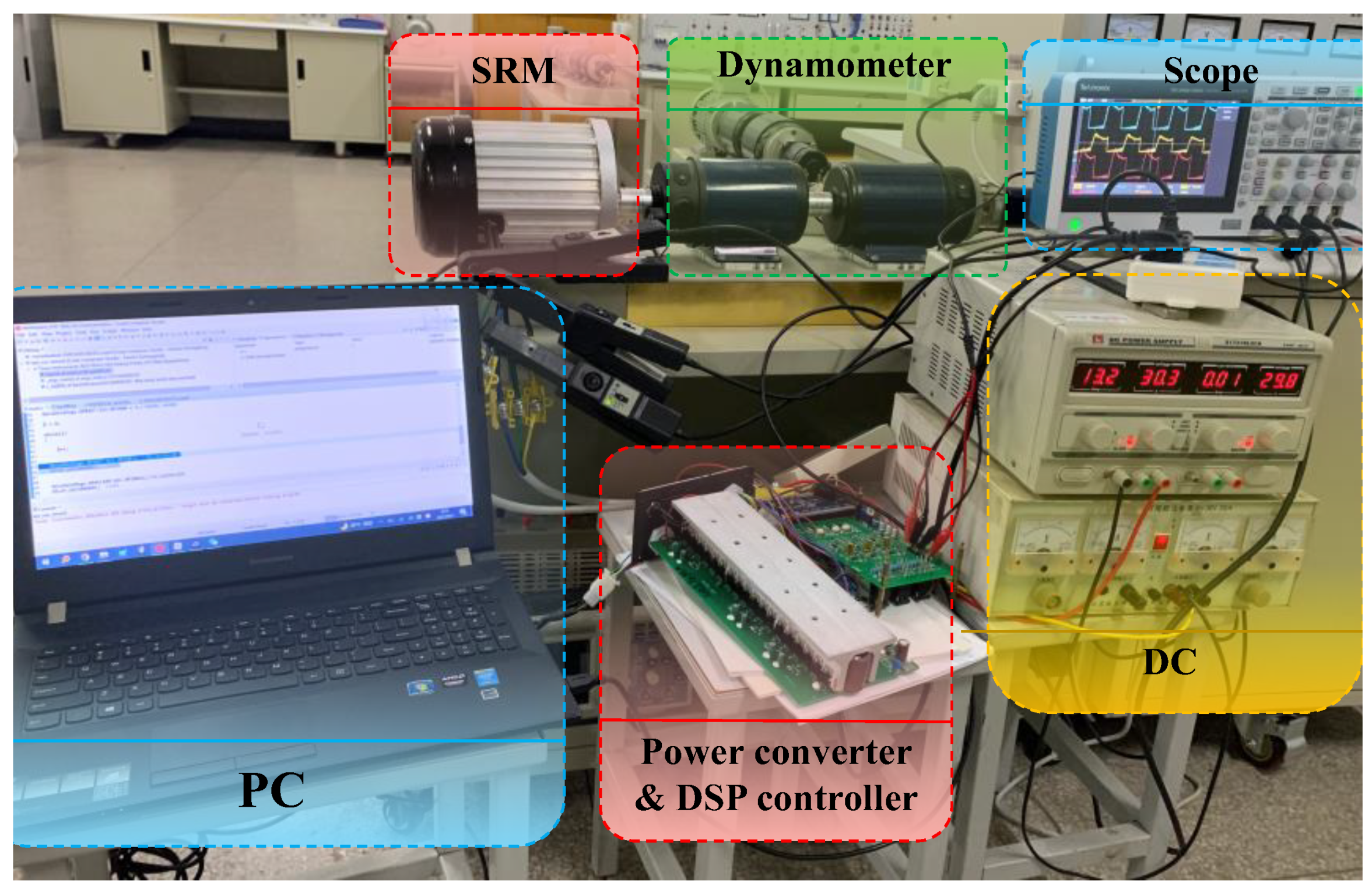

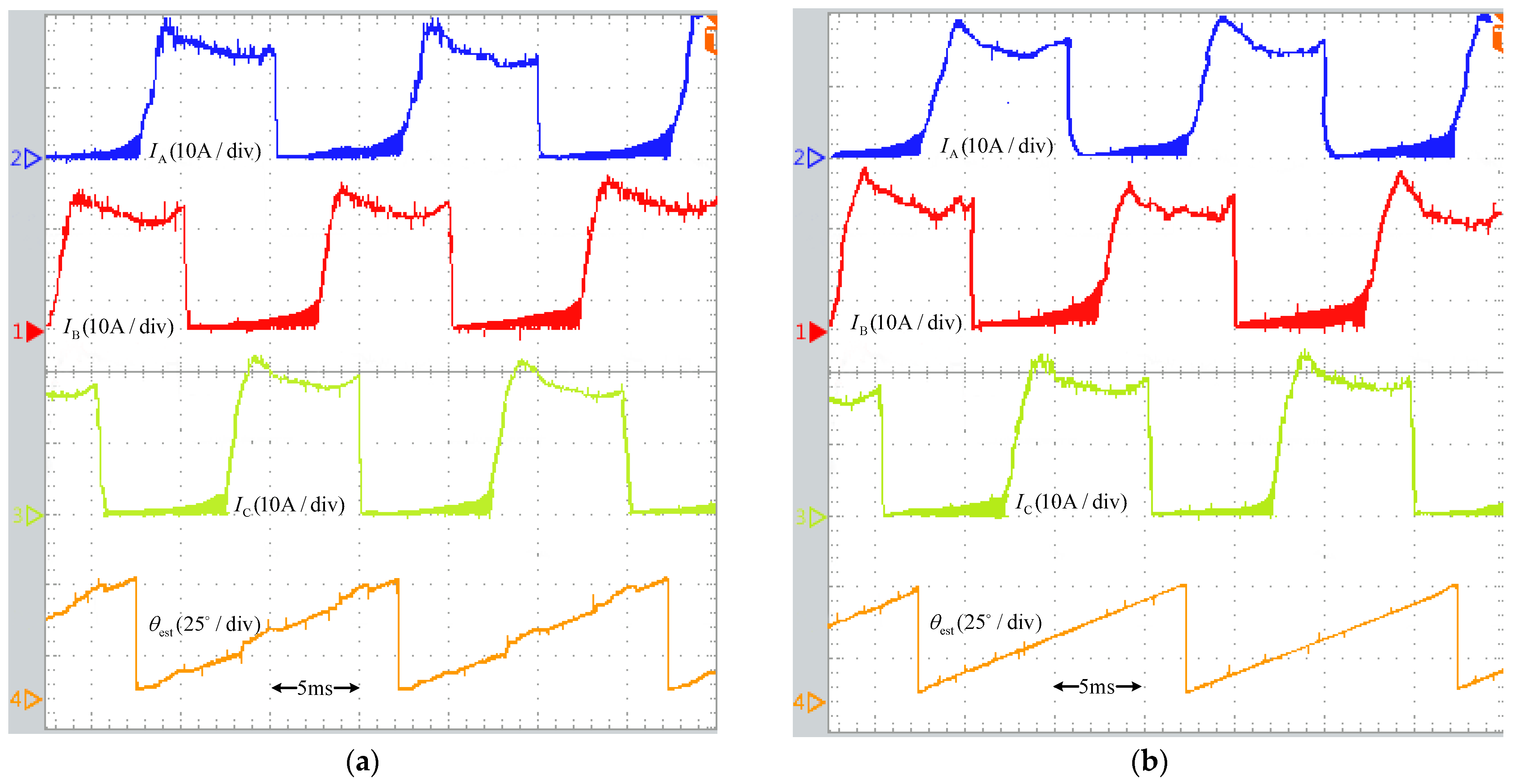
| Major Parameters | Values | Major Parameters | Values |
|---|---|---|---|
| Outside diameter of stator | 138 mm | Stator Pole Radian | 17.7° |
| Outer diameter of rotor | 80.7 mm | Rotor Pole Radian | 16.65° |
| The core is stacked long | 97.8 mm | Stator yoke height | 8.8 mm |
| Air gap | 0.35 mm | Rotor yoke height | 7.25 mm |
| Major Parameters | Values | Major Parameters | Values |
|---|---|---|---|
| Rated Power | 1.5 kW | Rated Load | 5 N·m |
| Bus Voltage | 60 V | Switching Frequency | 10 kHz |
| Rated Speed | 2000 r/min | Given motor speed | 400 r/min |
| Rated Current | 25 A | Median inductance | 1.276 mH |
| Control Strategy | Simulation Position Estimation Errors | Experiment Position Estimation Errors | ||
|---|---|---|---|---|
| 2 N·m | 5 N·m | 2 N·m | 5 N·m | |
| The linear zone method | 2.1° | 9.3° | 3.6° | 5.8° |
| The proposed methods | 1.3° | 2.7° | 2.5° | 2.7° |
| Control Strategy | Offline Measurements | Computation Burden | Driving with Load | Storage Memory Occupation |
|---|---|---|---|---|
| The linear zone method [30] | Yes | Low | No | Small |
| Intelligent schemes [18,27] | Yes | High | Yes | Large |
| RPLL based method [29] | No | Medium | Yes | Small |
| Unsaturated inductance model based methods [25,26] | Yes | Medium | No | Small |
| Flux-linkage based methods [13] | Yes | Low | Yes | Small |
| The proposed methods | No | Low | Yes | Small |
Disclaimer/Publisher’s Note: The statements, opinions and data contained in all publications are solely those of the individual author(s) and contributor(s) and not of MDPI and/or the editor(s). MDPI and/or the editor(s) disclaim responsibility for any injury to people or property resulting from any ideas, methods, instructions or products referred to in the content. |
© 2023 by the authors. Licensee MDPI, Basel, Switzerland. This article is an open access article distributed under the terms and conditions of the Creative Commons Attribution (CC BY) license (https://creativecommons.org/licenses/by/4.0/).
Share and Cite
Ni, F.; Zhang, W.; Bi, Y.; Li, B. The Study of SRM Sensorless Control Strategy Based on SOGI-FLL and ADRC-PLL Hybrid Algorithm. Electronics 2024, 13, 2. https://doi.org/10.3390/electronics13010002
Ni F, Zhang W, Bi Y, Li B. The Study of SRM Sensorless Control Strategy Based on SOGI-FLL and ADRC-PLL Hybrid Algorithm. Electronics. 2024; 13(1):2. https://doi.org/10.3390/electronics13010002
Chicago/Turabian StyleNi, Fuyin, Wenchao Zhang, Yuchun Bi, and Bo Li. 2024. "The Study of SRM Sensorless Control Strategy Based on SOGI-FLL and ADRC-PLL Hybrid Algorithm" Electronics 13, no. 1: 2. https://doi.org/10.3390/electronics13010002




